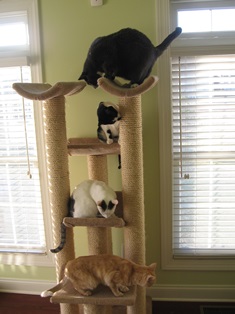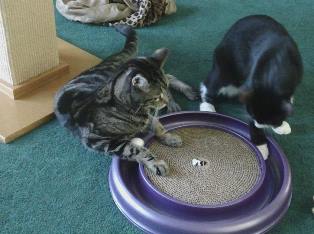We are often asked by our clients why their cat is displaying various negative behaviors. These behaviors range from inappropriate scratching, aggression toward other pets or people, excessive shyness or hiding, and urinating or defecating outside the litter box.
Once any medical issues are ruled out, the negative behaviors can be turned to positive simply by enriching your cat’s environment.
Why is environmental enrichment necessary?
Cats are predatory by nature. Therefore, they exhibit territorial behavior and are easily under stimulated if the essential elements in their home environment don’t exist to prevent boredom while ensuring the cat’s security. When these needs are not met, undesirable behaviors develop.
When a cat does not expend energy on hunting, his/her pent up frustration and stress can easily be redirected into behaviors such as marking territory by scratching the furniture, exhibiting aggression, and litter box issues.
Other things such as variable schedules, decreased interactions with caregivers, and unexpected physical manipulations can result in anxiety and hiding behaviors.
Ways to enrich a cat’s environment
Proper environmental enrichment means making the cat’s home more physically, socially and temporally complex. This sounds hard, but it is actually easy to do. Here are some suggestions:
1. Make a variety of engaging toys available that can stimulate their hunting instinct through play. Rotate toys to prevent boredom. Offer structured play sessions with string toys and lasers – cats enjoy interaction with their human caregivers as much as other feline playmates.
2. Ideally, provide one litter box per cat plus one. Litter boxes should be placed in easily accessible locations away from food. Scoop daily – cats are fastidious and will shy away from dirty litter.
3. Scratching posts are essential. Sisal is highly recommended as a first choice. Pay attention to your cat’s preference for horizontal and vertical options and offer more than one type and material.
4. Tall, multi-tiered cat trees provide safe resting areas as well as scratching and play opportunities.

Social enrichment – sisal scratching post
How to mitigate aggressive behavior
Cats often display aggressive behaviors as a result of feeling threatened. This anxiety and stress can be brought on by the presence of other pets in the home, (new or existing), the scent of other cats brought into the home, or overly excited play with children.
Therefore, it’s important to provide cats with plenty of hiding opportunities in the home where they can retreat and relax when feeling anxious. Cats will naturally gravitate to high shelves, tall furniture, pet hammocks or cat trees where they can perch above the ground and feel safe. Cardboard boxes and crinkle bags provide hiding places at ground level as well as play opportunities to reduce stress.

A good guideline to follow is to have one resting space and hiding space per cat in each room the cat frequents.
Remember to always rule out medical issues first
Simply by understanding why your cat is displaying negative behavior is the first step in correcting the behavior.
Remember, underlying illness must always be ruled out first. Missing the litter box and misplaced aggression can be the result of several medical issues that must be diagnosed by your veterinarian. Never hesitate to contact your veterinarian to discuss your cat’s behavior issues.
Recommended Reading:
Some pet behaviors may be related to hidden illness
Dr. Joe Martins, DVM, Belle Mead Animal Hospital

Dr. Joe Martins, DVM, Belle Mead Animal Hospital



